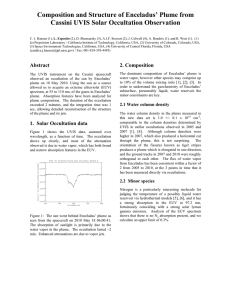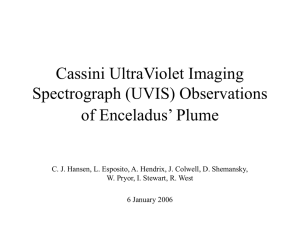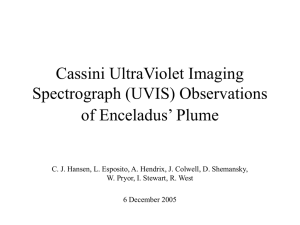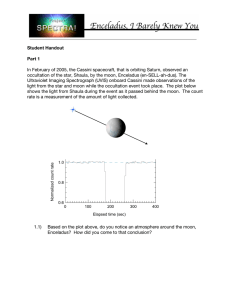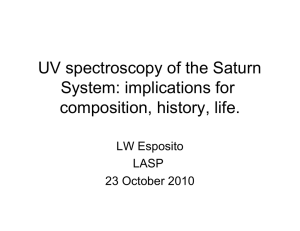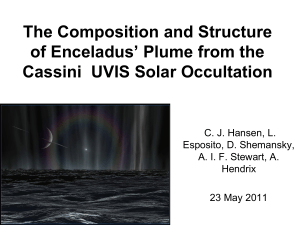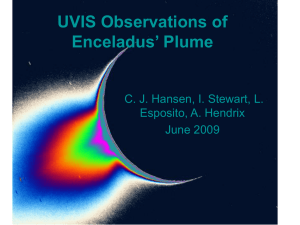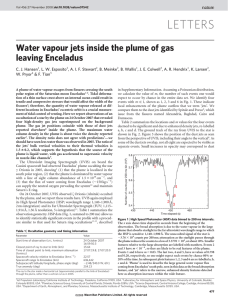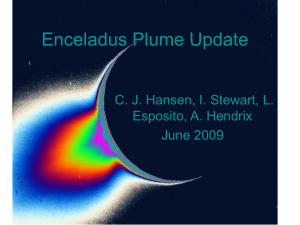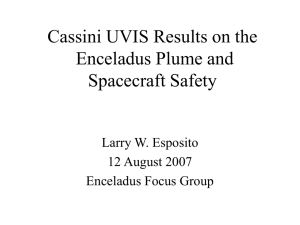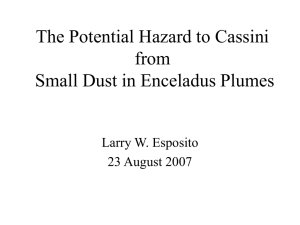Enceladus water jet models from UVIS star occultations 19 June 2009
advertisement
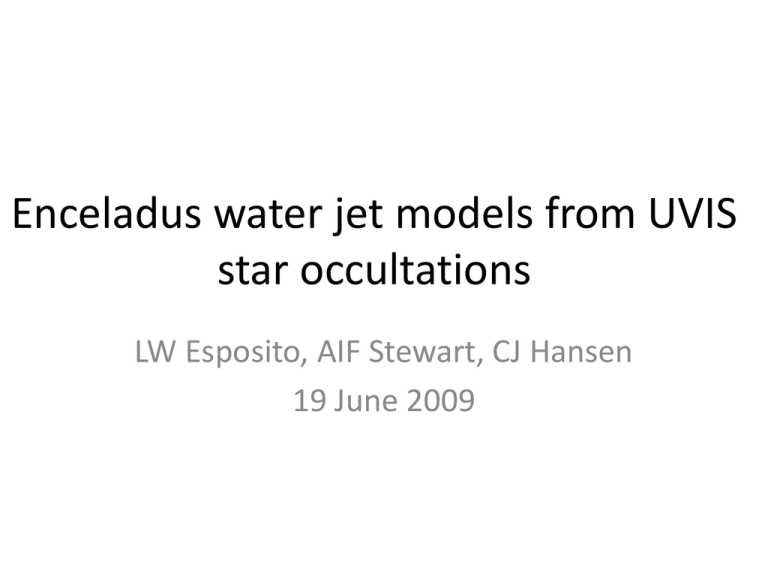
Enceladus water jet models from UVIS star occultations LW Esposito, AIF Stewart, CJ Hansen 19 June 2009 UVIS UVIS has 4 separate channels: • Far UltraViolet (FUV) • 110 to 190 nm • 3 slit widths => 2.8, 4.8, 24.9 nm spectral resolution • 2D detector: 1024 spectral x 64 onemrad spatial pixels • Extreme UltraViolet (EUV) • 55 to 110 nm • 3 slit widths => 2.8, 4.8, 19.4 nm spectral resolution • 2D detector: 1024 spectral x 64 onemrad spatial pixels • Solar occultation port • High Speed Photometer (HSP) • 2 - 8 msec time resolution • Hydrogen – Deuterium Absorption Cell (HDAC) For the occultations we used the • HSP with 2 msec time resolution • FUV with 512 spectral channels (1.56 nm resolution), 5 sec integration time Plume Composition is Water Vapor I=I0 exp (-n* ) I0 computed from 25 unocculted samples n = column density = absorption cross-section, function of wavelength The absorption spectrum of water is shown compared to Enceladus’ plume spectrum (I/I0) for a water column density of n = 1.5 x 1016 cm-2 Estimation of Enceladus Water Flux • S = flux = N * h2 * v = n/h * h2 * v = n*h*v Where N = number density / cm3 h2 = area v = velocity n = column density measured by UVIS Estimate h from plume dimension, = 80 km Estimate v from thermal velocity of water molecules in vapor pressure equilibrium with warm ice (600 m/sec for surface temperature ~ 180K – note that escape velocity = 230 m/sec) h v S = 1.5 x 1016 * 80 x 105 * 60 x 103 = 0.7 x 1028 H2O molecules / sec = 200 kg / sec Can we detect Ethylene in Enceladus’ Plume? • • • INMS detects a species with atomic mass = 28 Previously thought that this must be CO or N2 New idea (consistent with other INMS data) is that it could be ethylene – C2H4 = 2 * 12 + 4 = 28 Ethylene at 3% H2O Column Density is not detectable by UVIS • Rev 11 gamma Orionis occultation • Ethylene plus water • C2H4 column density = 4.8 x 1014 cm-2 • H2O column density = 1.6 x 1016 cm-2 Plume Structure (2005) Water vapor abundance calculated from each 5 sec spectrum. The 2005 water profile is best fit by an exponential curve. The best fit scale length is 80 km Optical Depth vs. Rayheight (2007) Minimum distance of rayheight above limb = 15.6 km S/C velocity = 22.57 km/sec Best fit is tau = 64.4 x z-2.33 - 0.007 Density at jets is ~2x higher than “background” plume 2007 High Speed Photometer (HSP) Data • HSP is sensitive to 1140 to 1900Å • Statistical analysis finds features that are statistically unlikely – Assumes signal is Poisson distribution – Compares to running mean • Six different bin sizes employed, absorptions compared, persistence of feature is part of test • m is the number of such events one would expect to occur by chance in the data set • m<<1 are likely to be real events Possible real features: 1 (a) m = 0.032 2 (b) m = 0.000008 3 (c) m = 0.00056 6 (d) m = 0.026 Groundtrack of Ray 2005 2007 Enhanced HSP absorption features a, b, c, and d can be mapped to dust jets located by Spitale and Porco (2007) along the tiger stripes a b c d Absorption Features, Compared to Dust Jet Locations Plotted here are: • Altitude above Enceladus' limb of the line-of-sight from Cassini to the star • Attenuation of the HSP signal, scaled by a factor of 300 • Projections of the 8 jets seen by the ISS into the plane of the figure • Jets assigned a length of 50 km (for purposes of illustration) • C/A marks the closest approach of the line-of-sight to Enceladus. • The times and positions at which the line-of-sight intersected the centerlines of the jets are marked by squares. The slant of the jets at Baghdad (VII) and Damascus (III) contribute to the overall width of the plume Plume or jets? • The plume of gas and dust from Enceladus includes a number of individual jets seen by Cassini camera and by UVIS • Gas Jets are idealized as sources along the line of sight with thermal and vertical velocity components • Source strength is varied to match the absorption profile. Gas Jet Model • The ratio of thermal velocity (vt) to vertical velocity (vb) is optimal at vt / vb = 0.65. • Higher thermal velocities would cause the streams to smear together and the HSP would not distinguish the two deepest absorptions as separate events. • At least 8 evenly-spaced gas streams are required to reproduce the overall width of the absorption feature (there may be more). Key Result: Vthermal / Vbulk = 0.65 Flow is supersonic Best fit of 8 sources from Spitale & Porco to match UVIS occultation profile Brightness of water vapor over Enceladus South pole from UVIS 8-jet model Summary of Results: PLUME • Attenuation in HSP data ~10% in 2007, ~6% in 2005 – Opposite of Hurford et al model of fissures opening and closing • Plume column density goes as ~ z-2 or as exp(-z/H) (z is minimum rayheight) • Water vapor flux ~200 kg/sec • No detection of CO, upper limit 3% (3 sigma) Summary of Results: JETS • 2007 HSP data shows 4 features with m < 0.1 (probability of chance occurrence). Typical half-width: 10 km at z = 15 km. • Gas jets can be correlated with dust jets mapped in images on Cairo, Alexandria, Damascus and Baghdad tiger stripes • Jet opacity corresponds to vapor density doubled within jets – Alternate explanation: no excess gas, with all increase due to dust. Then, dust opacity peaks at 0.05 in the jets. This would give 50x more mass in dust compared to vapor within the jet. • Ratio of thermal velocity to vertical velocity in jet = 0.65 – Gas is supersonic: Mach 1.5 • Eight or more jets required to reproduce width and shape of absorption, some evidence for diffuse sources • Jet source area is smaller than 300 m x 300 m Backup Slides Plume Model • Monte Carlo simulation of test particles given vertical + thermal velocity, particle trajectories tracked under influence of gravity and collisions (Tian et al, 2006) • Original model had arbitrary source spacing along the tiger stripes • Model now adapted for specific locations of the 8 dust jets identified by Spitale and Porco, actual viewing geometry of these sources as seen from the spacecraft The results shown here have T surface = 140 K V thermal = 359 m/sec V vertical = 552 m/sec For Tsurface = 180 K (from CIRS) V thermal = 406 m/sec V vertical = 624 m/sec Solar Occultation Rev 131 • We have the opportunity to observe an occultation of the sun on Rev 131 • New results are in the EUV, which gives us access to a different wavelength range than the FUV • The big scientific payoff is the chance to definitively detect / measure nitrogen in the plume - important for models of chemistry-driven dynamics in the interior Solar Occultation How well can UVIS measure N2 with a solar occultation? • Abundance of H2O measured by UVIS = 1.5 x 1016 cm-2 • Mixing ratio of mass 28 in the INMS experiment at Enceladus was [M28]/[H2O]=0.036 • A solar occultation has been simulated for our H2O optical depth assuming a commingled mixture of H2O and N2 in the spectral region of the H Ly line • The ability to measure N2 in a mixing ratio of [N2]/[H2O] = 0.005 is indicated, for an abundance of N2 = 1 x 1014 cm-2 How do we know? • N2 was measured above the exobase in the UVIS T10 solar occultation observation using the measured extinction of the sol H Ly line by the N2 b(3,0) band. Solar Occultation • This is a simulation of the results we could get from a solar occultation by Enceladus’ plume • UVIS can detect N2 absorption near 972 Ang • Mixing ratio for blue curve, showing clear absorption, is 0.05, close to the INMS derived value of [M28/H2O] = 0.036 • Green curve shows likely detection limit with an order of magnitude less nitrogen, or [M28/H2O] = 0.005 Enceladus Plume Occultation of zeta Orionis October 2007 • In October 2007 zeta Orionis was occulted by Enceladus’ plume • Perfect geometry to get a horizontal cut through the plume and detect density variations indicative of gas jets • Objective was to see if there are gas jets corresponding to dust jets detected in images Changes in System Oxygen Content Plume or jets? • Attempt to pick comparable “box” between 2005 and 2007 • But different jets visible means comparing apples and oranges Gas Jets Density in jets is twice the background plume Gas jet typical width = 10 km at 15 km altitude Ingress a. Cairo (V) Feature Feature Number Letter m Occultation Occultation latitude west longitude Likely associated dust jet 1 a 0.032 -79 82 Cairo (V) 2 b 0.000008 -86 112 Alexandria (IV) 3 c 0.00056 -86 192 Baghdad (VI) 6 d 0.026 -84 217 Damascus (II) Egress d. Damascus (II) c. Baghdad (VI) b. Alexandria (IV) Closest point Comparison to tidal energy model • Hurford et al 2007 model predicts tidallycontrolled differences in eruption activity as a function of where Enceladus is in its eccentric orbit • Substantial changes are not seen in the occultation data, although they would be predicted, based on this model • Expect fissures to open and close Position of Enceladus in its orbit at times of stellar occultations Taken from Hurford et al, Nature 447:292 (2007) True Anomaly (deg) Fraction of orbit from Periapsis Position in Orbit Stress 105 Pa 0 0.0 Periapsis 0.3 90 0.25 One quarter -0.8 97.76 0.27 July 14, 2005 -0.77 180 0.5 Apoapsis -0.4 254.13 0.7 October 24, 2007 0.4 270 0.75 Three quarter 0.6 New Plume Model • A new model has been developed for Enceladus’ plumes by Tian, Toon, Larsen, Stewart and Esposito, paper published in Icarus (2006) • Monte Carlo simulation of test particles given vertical + thermal velocity, particle trajectories tracked under influence of gravity and collisions • Assumes source of one plume is 2 x 2 km2, then multiple plumes added together along a tiger stripe, w/ 20 km separation UVIS ray path across tiger stripes Localization of Enceladus’ Plume (Not a global atmosphere) • Ray intercepts were at latitude / west longitude: 15 / 300 -31 / 141 -76 / 86 -0.2 / 28 Lambda Sco ingress (non-detection) Lambda Sco egress (non-detection) Gamma Ori ingress Gamma Ori egress (non-detection) Consistent with localized plume or jet: – Enceladus’ gravity insufficient to hold gravitationally bound sputtered atmosphere – Also, the combination of other Cassini data sets are consistent with a plume of water vapor coming from Enceladus’ “Tiger Stripes” driven by the hot spot at the south pole detected by CIRS FUV summed over wavelength
